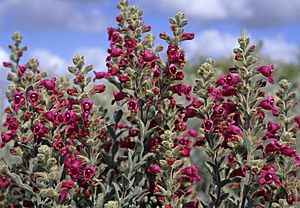Dasymalla facts for kids
Quick facts for kids Dasymalla |
|
|---|---|
 |
|
| Dasymalla terminalis near Mullewa | |
| Scientific classification |
|
| Kingdom: | Plantae |
| Clade: | Tracheophytes |
| Clade: | Angiosperms |
| Clade: | Eudicots |
| Clade: | Asterids |
| Order: | Lamiales |
| Family: | Lamiaceae |
| Subfamily: | Prostantheroideae |
| Genus: | Dasymalla Endl. |
| Species | |
|
See text |
|
| Synonyms | |
|
|
Dasymalla is a group of five types of flowering plants. They belong to the mint family, called Lamiaceae. These plants are found only in Western Australia.
Plants in the Dasymalla group are usually woolly shrubs. Their flowers have five petals that join together to form a tube shape. Each flower also has four stamens, which are parts that produce pollen. These stamens are not all the same length. Dasymalla plants are similar to plants in the Pityrodia group. However, their fruit is different because it does not open to release its seeds when it is ripe.
Contents
What Dasymalla Plants Look Like
Dasymalla plants are evergreen shrubs. This means they keep their leaves all year round. They are covered with thick, woolly hairs. Their leaves are simple and shaped like an egg. They grow in pairs, opposite each other on the stem. The leaves are also covered in woolly hairs.
The flowers grow one by one where the leaves meet the stem. Each flower has five sepals, which are like small leaves that protect the bud. These sepals are joined at their base, forming a short tube with five small tips. The five petals form a curved tube. At the end of the tube, there are five lobes or sections. The upper lobes are shorter than the lower ones. Inside the flower, there are four stamens. The bottom two stamens are shorter than the top two. When the fruit grows, it does not open to release its seeds. It also has a noticeable hump.
How Dasymalla Got Its Name
The group of plants called Dasymalla was first described by a scientist named Stephan Endlicher. He wrote about it in 1839 in his book Novarum Stirpium Decades.
Later, in 1979, another scientist named Ahmad Abid Munir moved some Dasymalla species into a different plant group called Pityrodia. He also described some new species.
Then, in 2011, three scientists named Barry Conn, Murray Henwood, and Nicola Streiber decided to bring these five species back into the Dasymalla group.
The five species of Dasymalla are:
- Dasymalla axillaris Endl.
- Dasymalla chorisepala (Munir) B.J.Conn & M.J.Henwood
- Dasymalla glutinosa (Munir) B.J.Conn & M.J.Henwood
- Dasymalla teckiana (F.Muell.) B.J.Conn & M.J.Henwood
- Dasymalla terminalis Endl.
Where Dasymalla Plants Grow
All five types of Dasymalla plants are found only in Western Australia. However, one species, D. chorisepala, can also be found in the Northern Territory. It grows close to the border with Western Australia.
See also
 In Spanish: Dasymalla para niños
In Spanish: Dasymalla para niños

